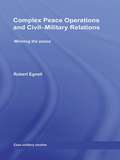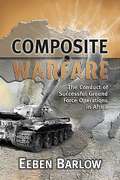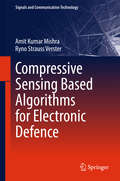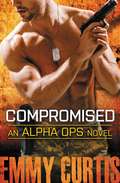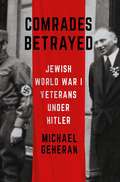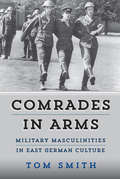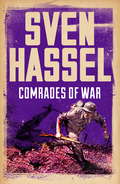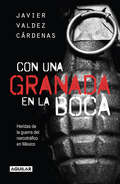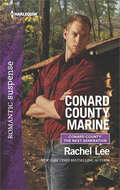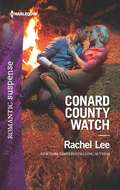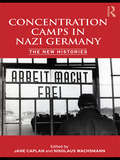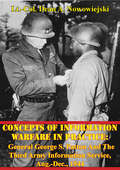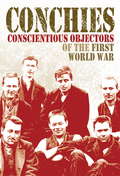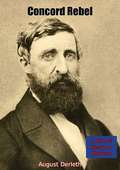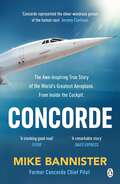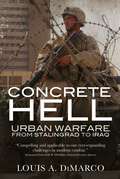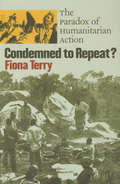- Table View
- List View
Complex Peace Operations and Civil-Military Relations: Winning the Peace (Cass Military Studies)
by Robert EgnellThis book explores the impact of different civil-military structures on operational effectiveness in complex peace operations. Recent operations in Iraq, Afghanistan and Somalia are examples of grand failures to enforce peace and to promote democracy and development through international interventions. A missing variable in analyses of these conflicts hitherto has been the nature of the civil-military interface and its impact. The principal argument of this book is that the civil-military interface should ideally be integrated within the interagency arena as well as within the defence ministry. Such integration has the potential to provide joint civil-military planning and comprehensive approaches to operations. It also creates mutual trust and understanding amongst officers and civil servants from different departments, agencies and units, and thereby, a co-operative interagency culture. For the civil-military interface to function effectively within the chain of command during operations, a co-operative culture of trust is essential. Crucially, structurally and culturally integrated civil-military structures are likely to provide a more balanced view of the functional imperative of the armed forces. The results are armed forces fit for whatever purpose the political leadership decides for them - including complex peace support operations. Empirically, the book applies the theoretical framework to a comparative study of US and British patterns of civil-military relations, their strategic cultures and their operations in Iraq. This book will be of much interest to students of peace operations, civil-military relations, humanitarian intervention, and security studies/IR in general. Robert Egnell is a lecturer in War Studies at the Swedish National Defence College and a senior researcher at the Swedish Defence Research Agency. He was awarded the 2008 Kenneth N. Waltz Dissertation Prize for the best thesis in the field of international security.
Composite Warfare: The Conduct Of Successful Ground Force Operations In Africa
by Eeben BarlowComposite Warfare presents African soldiers and scholars with a true African ‘Art of War’. As a continent, Africa presents her armies with a vast, dynamic and multidimensional operating environment. It has numerous complex and diverse ethnic, religious, cultural and tribal interests and loyalties, along with many multifaceted threat-drivers coupled to varied and infrastructure-poor terrain plus vast climatic variations. The continent is, furthermore, characterized by numerous half-won conflicts and wars fought by incorrectly structured, inadequately trained and ill-equipped armies. For many reasons, these forces have difficulty adapting to the complex, demanding and rapidly changing environments they do battle in. Similarly, the armies have difficulty in decisively defeating the various threats they face. Many of these problems stem from the fact that numerous modern-day African armies are merely clones of the armies established by their once-colonial masters, their Cold War allies or their new international allies. Many of the principles and tactics, techniques and procedures they were – and still are – being taught relate to fighting in Europe and not in Africa. Some of these concepts are not even relevant to Africa. This book is intended as a guide and textbook for African soldiers and scholars who wish to understand the development of hostilities, strategy, operational design, doctrine and tactics. It also illustrates the importance of nonpartisanship and the mission and role of the armed forces. Officers, NCOs and their subordinates need to, furthermore, understand their role in defending and protecting the government and the people they serve. They additionally need to know how to successfully accomplish their numerous missions with aggression, audacity, boldness, speed and surprise. The book provides the reader with valuable information relating to conventional and unconventional maneuver. It also discusses how African armies can, with structured and balanced forces, achieve strategic, operational and tactical success. It covers the role of government along with operations related to war, operations other than war and intelligence operations and how these operations, operating in a coordinated and unified manner, can secure and strengthen a government. Composite Warfare draws on the author’s experiences and lessons in Central, Southern, East, West and North Africa where he has served numerous African governments as a politico-military strategist, division commander, division adviser, battalion commander and special operations commander.
Compressive Sensing Based Algorithms for Electronic Defence (Signals and Communication Technology)
by Amit Kumar Mishra Ryno Strauss VersterThis book details some of the major developments in the implementation of compressive sensing in radio applications for electronic defense and warfare communication use. It provides a comprehensive background to the subject and at the same time describes some novel algorithms. It also investigates application value and performance-related parameters of compressive sensing in scenarios such as direction finding, spectrum monitoring, detection, and classification.
Compromised (Alpha Ops #5)
by Emmy CurtisIt was supposed to be the happiest day of her life. But when her wedding erupts in gunfire, Sadie Walker realizes this is not the life she wants-her fiancé's work with Delta Force will always cast a shadow over their relationship. After leaving the hard-muscled hero at the altar, she thinks she'll never see him again . . . until a chance encounter reveals that he still has a strong grip on her heart. On a covert assignment overseas, Simon Tennant is shocked when he spots Sadie with another man. Jealousy flares, as does an irresistible urge to keep her protected. Amid a dangerous game of international espionage, he'll have to convince Sadie just how perfect they've always been together. This time, nothing will take precedence over winning her back, no matter the cost to his cover-or his life . . . More in the Alpha Ops series:DANGEROUS TERRITORY (novella)OVER THE LINEPUSHING THE LIMITBLOWBACK
Compromised: A Thriller
by Tom SaricAn action-packed novel of international terrorism, modern-day pirates, and a CIA operative trying to stop a mass casualty event . . . Dr. Paul Alban lives a seemingly simple life, running a medical aid clinic in Somalia. Unknown to his patients, he&’s also an operative for the CIA. His time in this assignment has been relatively mundane—until a pair of Somali pirates enter Paul&’s clinic for treatment. The meeting sets off a violent chain of events. A mysterious container has been taken from a recently pirated vessel. A band of terrorists is trying to get the deadly cargo inside, and end countless innocent lives. Now only Paul can stop them. But first he must confront his past, and the betrayal of those he trusted most. Because Paul has been hiding secrets of his own—and with the fate of thousands in his hands, he can&’t run any longer.
Comrades Betrayed: Jewish World War I Veterans under Hitler (Battlegrounds: Cornell Studies in Military History)
by Michael GeheranAt the end of 1941, six weeks after the mass deportations of Jews from Nazi Germany had begun, Gestapo offices across the Reich received an urgent telex from Adolf Eichmann, decreeing that all war-wounded and decorated Jewish veterans of World War I be exempted from upcoming "evacuations." Why this was so, and how Jewish veterans at least initially were able to avoid the fate of ordinary Jews under the Nazis, is the subject of Comrades Betrayed. Michael Geheran deftly illuminates how the same values that compelled Jewish soldiers to demonstrate bravery in the front lines in World War I made it impossible for them to accept passively, let alone comprehend, persecution under Hitler. After all, they upheld the ideal of the German fighting man, embraced the fatherland, and cherished the bonds that had developed in military service. Through their diaries and private letters, as well as interviews with eyewitnesses and surviving family members and records from the police, Gestapo, and military, Michael Geheran presents a major challenge to the prevailing view that Jewish veterans were left isolated, neighborless, and having suffered a social death by 1938. Tracing the path from the trenches of the Great War to the extermination camps of the Third Reich, Geheran exposes a painful dichotomy: while many Jewish former combatants believed that Germany would never betray them, the Holocaust was nonetheless a horrific reality. In chronicling Jewish veterans' appeal to older, traditional notions of comradeship and national belonging, Comrades Betrayed forces reflection on how this group made use of scant opportunities to defy Nazi persecution and, for some, to evade becoming victims of the Final Solution.
Comrades in Arms: Military Masculinities in East German Culture
by Tom SmithWithout question, the East German National People’s Army was a profoundly masculine institution that emphasized traditional ideals of stoicism, sacrifice, and physical courage. Nonetheless, as this innovative study demonstrates, depictions of the military in the film and literature of the GDR were far more nuanced and ambivalent. Departing from past studies that have found in such portrayals an unchanging, idealized masculinity, Comrades in Arms shows how cultural works both before and after reunification place violence, physical vulnerability, and military theatricality, as well as conscripts’ powerful emotions and desires, at the center of soldiers’ lives and the military institution itself.
Comrades of War (Sven Hassel War Classics)
by Sven HasselThere were not so much people as animals. Sometimes small and frightened, huddling together in cattle cars, wounds gaping, tongues swelling even as they licked the moist frost from the walls...Grievously wounded - having survived the operating table and the perilous journey West on a freezing freight train - Sven Hassel and his comrades find themselves behind the lines in a Hamburg hospital. The Reich is a hotbed of lies, betrayal and propaganda. Disgusted by the Nazi cause, the comrades drink themselves into oblivion, visit brothels where women dance naked on saloon tables and reach for home comforts before they return to the dreaded Russian Front. Because Hitler's war must go on... COMRADES OF WAR is a gritty portrayal of war's harsh realities and the fear and fanaticism at the heart of The Third Reich.Sven Hassel's unflinching narrative is based on his own experiences in the German Army. He began writing his first novel, LEGION OF THE DAMNED in a prisoner of war camp at the end of the Second World War.
Comrades of War [Illustrated Edition]
by Sverre Lyngstad Sven HasselIncludes the World War Two On The Eastern Front (1941-1945) Illustration Pack - 198 photos/illustrations and 46 maps.DO NOT EXPECT TO LIKE THE PEOPLE IN THIS BOOK--Because they are not so much people as animal--Sometimes small and scared and lost as they huddle together in cattle cars, wounds gaping, tongues swelling even as they lick the moist frost off the walls, each of them wondering if he'll be the next to die before they reach the field hospital...Sometimes brawling, booting, robbing and raping as they sweep into Hamburg and glut themselves on life for one more day one wild might.And sometimes they are heroes, pushing through the Russian lines--Tiny, the Legionnaire, Sven, all of them knowing that they will be massacred, all of them knowing they've lost the war--and every shred of their own humanity.NORWAY: "In an almost magic way Sven Hassel unites the powerful style of Ernest Hemingway with Remarque's unique way of writing. The unknown soldier of the Second World War has got his monument!"--Morgenavisen, BergenFRANCE: "Sven Hassel has proved to be the classic war book author of the Second World War."--Tribune Libre, ParisSPAIN: "He is 'the Danish Hemingway.'"--Diario de Barcelona
Con ojos de mujer: Relatos en medio de la guerra
by Fernando Millán CruzEl conflicto colombiano y la paz desde una perspectiva femenina. Este es un libro de testimonios en el que Fernando Millán da a conocer las historias de nueve exguerrilleras de las FARC y el papel que tuvieron como mujeres en el conflicto colombiano. En estos impactantes relatos ellas cuentan, en primera persona, cómo llegaron a las FARC, cuáles fueron sus motivaciones para permanecer ahí durante varios años, cómo era la vida allí y qué viene para ellas ahora, después de los acuerdos de paz de La Habana.
Con una granada en la boca. Heridas de guerra del narcotráfico en México: Heridas de guerra del narcotráfico en México
by Valdez Cárdenas JavierSin duda, el mejor escritor de México, con reconocimiento internacional, en temas relacionados con el narcotráfico y delincuencia organizada, este libro doloroso, valiente y conmovedor es una prueba más de su talento periodístico. Implacable, profundamente humano, sin reparos en la indagación periodística, Javier Valdez Cárdenas es uno de los periodistas sobre narcotráfico más respetados en México. En Con una granada en la boca elabora un recuento de los daños sincero, doloroso y sin reparos en el ofrecimiento de sus testimonios terribles ; apoyado en la opinión de analistas y expertos como Ricardo Ravelo, Paco Ignacio Taibo II y Luis Astorga, mezcla el dato duro y los sentimientos de sicarios y víctimas. En estas páginas sus reportajes hablan del dolor de una mujer con una granada en la boca, del hermano perdido en el vicio de la droga o de la humillación a las víctimas por parte de narcos o militares.Con este libro Javier Valdez confirma por qué su trabajo también es seguido con admiración en el ámbito internacional y cómo su escritura audaz y violenta, sin soslayar el sufrimiento y la entereza de la condición humana, le han dado un sitio de prestigio entre los periodistas latinoamericanos contemporáneos.
Conard County Marine: Conard County Marine High-stakes Colton Cold Case Recruit Safe In His Sight (Conard County: The Next Generation #31)
by Rachel LeeFrom the New York Times–bestselling author comes “a dramatic, suspenseful tale” of one woman’s survival and her protector’s promise to find answers (Fresh Fiction).The arrival of a single black rose signals danger to come for Kylie Brewer. Recovering from a brutal attack that claimed three years of her memory and her chance at a promising career, Kylie just wants to pick up the remaining fragments of her life. She returns to her hometown of Conard City to live with her sister but soon learns that putting the past in its place won’t be easy. Marine sergeant Evan Cooper—a trusted family friend who agrees to help Kylie—can’t ignore his protective instincts. Or the steadily growing desire he feels for a woman who has overcome so much. He vows to help keep Kylie’s demons at bay . . . but someone else has plans to finish what they started.Praise for the novels of Rachel Lee“A page-turner full of mystery and suspense, keeping the reader engaged every step of the way.” —Fresh Fiction“While the relationship-building excels, it is the heroine’s strength in the face of such personal adversities that is the real scene-stealer.” —RT Book Reviews“[Rachel Lee]’s deft use of dialogue to make her stories convincing works as well with conspiracy theories as with contemporary romances.” —Publishers Weekly
Conard County Protector (Conard County: The Next Generation #52)
by Rachel LeeBack to Conard County Back under fire. In town for a wedding, Sergeant Jax Stone is &“asked&” to stick around Conard County to investigate a suspicious fire. He never expects boarding with widow Lynn Macy to give him the taste of family he&’d craved. And while helping Lynn renovate her house has the Marine falling for her, Jax's past brings peril to her doorstep. To keep her safe, his only choice may be to give her up…From Harlequin Romantic Suspense: Danger. Passion. Drama.Feel the excitement in these uplifting romances, part of the Conard County: The Next Generation series:Book 1: A Soldier's HomecomingBook 2: Protector of OneBook 3: The Unexpected HeroBook 4: The Man from NowhereBook 5: Her Hero in HidingBook 6: A Soldier's RedemptionBook 7: No Ordinary HeroBook 8: The Final MissionBook 9: Just a CowboyBook 10: The Rescue PilotBook 11: Guardian in DisguiseBook 12: The Widow's ProtectorBook 13: Rancher's Deadly RiskBook 14: What She SawBook 15: Rocky Mountain LawmanBook 16: Killer's PreyBook 17: Deadly HunterBook 18: Defending the EyewitnessBook 19: Snowstorm ConfessionsBook 20: Undercover HunterBook 21: Thanksgiving DaddyBook 22: Reuniting with the RancherBook 23: A Conard County BabyBook 24: The Lawman Lassoes a FamilyBook 25: Playing with FireBook 26: A Cowboy for ChristmasBook 27: Conard County WitnessBook 28: A Secret in Conard CountyBook 29: Conard County SpyBook 30: An Unlikely DaddyBook 31: Conard County MarineBook 32: Undercover in Conard CountyBook 33: His Pregnant Courthouse BrideBook 34: A Conard County HomecomingBook 35: Cornered in Conard CountyBook 36: A Conard County CourtshipBook 37: Conard County RevengeBook 38: Conard County WatchBook 39: A Bachelor, a Boss and a BabyBook 40: Murdered in Conard CountyBook 41: Stalked in Conard CountyBook 42: Conard County JusticeBook 43: Conard County: Hard ProofBook 44: Conard County: Traces of MurderBook 45: Conard County: Christmas BodyguardBook 46: Conard County: Mistaken IdentityBook 47: Conard County: Christmas Crime SpreeBook 48: Hunted in Conard CountyBook 49: Conard County ConspiracyBook 50: Conard County Protector
Conard County Watch: Colton's Twin Secrets (the Coltons Of Red Ridge) / Conard County Watch (conard County: The Next Generation) (Conard County: The Next Generation #39)
by Rachel LeeOne marine meets his match on Thunder Mountain A thrilling Conard County: The Next Generation romanceArchaeologist Renee Dubois is used to digging up the past, not falling headlong into intrigues of the present. But trouble comes her way when she meets former marine Carter Copeland, whose cool-and-collected demeanor contrasts with his lethally sexy looks. As Carter and Renee stumble across a deadly secret, they must race against time to survive.
Conceived in Liberty: A Novel of Valley Forge
by Howard FastA stunning novel of American revolutionaries battling the brutal winter at Valley Forge—from the &“literary phenomenon&” and author of Spartacus (The Guardian). General George Washington&’s twelve thousand soldiers march into Valley Forge, Pennsylvania, under-fed and under-clothed, their frozen feet leaving bloody tracks in the snow. Shortly after the soldiers establish quarters for the cold months ahead, disease begins to rip through the camp. The men, helpless against sickness and despair, are facing the longest winter of their lives—and their survival will determine the fate of their young nation. Passionate and unforgettable, Conceived in Liberty is one of Fast&’s rawest accounts of the brutality of the Revolutionary War, and of the heroism of its soldiers. This ebook features an illustrated biography of Howard Fast including rare photos from the author&’s estate.
Conceived in Liberty: Joshua Chamberlain, William Oates, and the American Civil War
by Mark PerryDiscussion of the Civil War with an emphasis on Gettysburg.
Concentration Camps in Nazi Germany: The New Histories
by Nikolaus Wachsmann Jane CaplanThe notorious concentration camp system was a central pillar of the Third Reich, supporting the Nazi war against political, racial and social outsiders whilst also intimidating the population at large. Established during the first months of the Nazi dictatorship in 1933, several million men, women and children of many nationalities had been incarcerated in the camps by the end of the Second World War. At least two million lost their lives. This comprehensive volume offers the first overview of the recent scholarship that has changed the way the camps are studied over the last two decades. Written by an international team of experts, the book covers such topics as the earliest camps; social life, work and personnel in the camps; the public face of the camps; issues of gender and commemoration; and the relationship between concentration camps and the Final Solution. The book provides a comprehensive introduction to the current historiography of the camps, highlighting the key conclusions that have been made, commenting on continuing areas of debate, and suggesting possible directions for future research.
Concepts Of Information Warfare In Practice: General George S. Patton And The Third Army Information Service, Aug.-Dec., 1944
by Lt.-Col. Dean A. NowowiejskiThis monograph looks for historical examples of information warfare in order to gain insight into its current practice. It first describes key elements of the concept of information operations, particularly as they relate to battle command. It then explores how George S. Patton and his Third Army Information Service demonstrated those ideas, and how their example offers direction for current developments in information warfare.Key sources used in research included emerging doctrinal literature on information warfare, biographical information on the professional development and command qualities of Patton, and after action reports of the Third Army and 6th Cavalry Group, the unit that constituted the Army Information Service.This monograph found that Patton aggressively sought information advantage as a battle commander, and that he demonstrated the key qualities of vision and intuition. The Third Army Information Service developed a relevant common picture of the battlefield by the expanding the instrument of directed liaison.What needs emphasis in current concept of information warfare is the improving the ability of commanders and staffs to process information. We must reemphasize the human dimensions of information operations through refined professional development.
Conceptualizing Mass Violence: Representations, Recollections, and Reinterpretations (Mass Violence in Modern History)
by Navras J. Aafreedi Priya SinghConceptualizing Mass Violence draws attention to the conspicuous inability to inhibit mass violence in myriads forms and considers the plausible reasons for doing so. Focusing on a postcolonial perspective, the volume seeks to popularize and institutionalize the study of mass violence in South Asia. The essays explore and deliberate upon the varied aspects of mass violence, namely revisionism, reconstruction, atrocities, trauma, memorialization and literature, the need for Holocaust education, and the criticality of dialogue and reconciliation. The language, content, and characteristics of mass violence/genocide explicitly reinforce its aggressive, transmuting, and multifaceted character and the consequent necessity to understand the same in a nuanced manner. The book is an attempt to do so as it takes episodes of mass violence for case study from all inhabited continents, from the twentieth century to the present. The volume studies ‘consciously enforced mass violence’ through an interdisciplinary approach and suggests that dialogue aimed at reconciliation is perhaps the singular agency via which a solution could be achieved from mass violence in the global context. The volume is essential reading for postgraduate students and scholars from the interdisciplinary fields of Holocaust and Genocide Studies, History, Political Science, Sociology, World History, Human Rights, and Global Studies.
Conchies: Conscientious Objectors of the First World War
by Ann KramerWhen, at the height of the First World War, many Allied governments introduced conscription, there were thousands of individuals who, for personal or religious reasons, refused to fight. After tough questioning, some were exempted but the majority were forced into the army anyways. Those who 'refused to do their duty' were threatened with death sentences or harsh prison terms; many died from ill treatment. Conchies collects many of the moving true stories of these brave individuals.
Conchies: Conscientious Objectors of the First World War (One Shot Ser.)
by Ann KramerWhen, at the height of the First World War, many Allied governments introduced conscription, there were thousands of individuals who, for personal or religious reasons, refused to fight. After tough questioning, some were exempted but the majority were forced into the army anyways. Those who 'refused to do their duty' were threatened with death sentences or harsh prison terms; many died from ill treatment. Conchies collects many of the moving true stories of these brave individuals.
Concord Rebel: A Life of Henry D. Thoreau
by August DerlethConcord Rebel is the life of Henry David Thoreau who, more than a century after his death, is on every list of America’s greatest writers. This book, which was first published in 1962, recaptures Thoreau’s life and work so fully that you will walk beside him down his bean rows at Walden pond, and feel the sting of white water on the Merrimack River.Truly, this is Thoreau, the man and writer.
Concorde: The thrilling account of history’s most extraordinary airliner
by Mike BannisterThe definitive account of the rise and fall of the iconic Concorde plane from British Airways' former Chief Concorde Pilot'A remarkable story' DAILY EXPRESS'A stonking good read' FLYER_________What's it like to fly faster than a bullet?Could you really glimpse the edge of space?Why will we never see Concorde's like again?Mike Bannister was British Airways' Chief Concorde Pilot. One of the few in that legendary aircraft's quarter-century of flight to fully understand both the plane's intricate engineering and what it took to fly her at supersonic speeds.In this definitive account of the rise and fall of the world's greatest aircraft, Bannister explores its origins, development, service, highs, lows and, finally, the terrible crash which ended its flying life.Part celebration, part history, part detective story and part courtroom drama, it's almost as riveting as flying in Concorde itself - almost . . ._________'Concorde represented the sheer wondrous genius of the human race' JEREMY CLARKSON
Concrete Hell: Urban Warfare From Stalingrad to Iraq
by Louis DimarcoThroughout history cities have been at the center of warfare, from sieges to street-fighting, from peace-keeping to coups de mains. Sun Tzu admonished his readers of The Art of War that the lowest realization of warfare was to attack a fortified city. Indeed, although strategists have advised against it across the millennia, armies and generals have been forced nonetheless to attack and defend cities, and victory has required that they do it well. In Concrete Hell Louis DiMarco has provided a masterful study of the brutal realities of urban warfare, of what it means to seize and hold a city literally block by block. Such a study could not be more timely. We live in an increasingly urbanizing world, a military unprepared for urban operations is unprepared for tomorrow. Di Marco masterfully studies the successes and failures of past battles in order to provide lessons for today's tacticians.
Condemned to Repeat?
by Fiona TerryHumanitarian groups have failed, Fiona Terry believes, to face up to the core paradox of their activity: humanitarian action aims to alleviate suffering, but by inadvertently sustaining conflict it potentially prolongs suffering. In Condemned to Repeat?, Terry examines the side-effects of intervention by aid organizations and points out the need to acknowledge the political consequences of the choice to give aid. The author makes the controversial claim that aid agencies act as though the initial decision to supply aid satisfies any need for ethical discussion and are often blind to the moral quandaries of aid. Terry focuses on four historically relevant cases: Rwandan camps in Zaire, Afghan camps in Pakistan, Salvadoran and Nicaraguan camps in Honduras, and Cambodian camps in Thailand. Terry was the head of the French section of Medecins sans frontieres (Doctors Without Borders) when it withdrew from the Rwandan refugee camps in Zaire because aid intended for refugees actually strengthened those responsible for perpetrating genocide. This book contains documents from the former Rwandan army and government that were found in the refugee camps after they were attacked in late 1996. This material illustrates how combatants manipulate humanitarian action to their benefit. Condemned to Repeat? makes clear that the paradox of aid demands immediate attention by organizations and governments around the world. The author stresses that, if international agencies are to meet the needs of populations in crisis, their organizational behavior must adjust to the wider political and socioeconomic contexts in which aid occurs.
